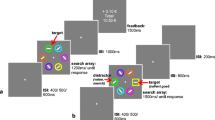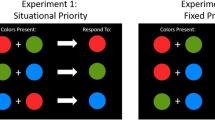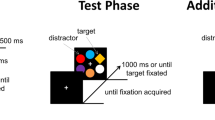The merit of an object, which is in any degree either useful or beautiful, is greatly enhanced by its scarcity.
Adam Smith (1937).
Abstract
Scarcity has been found to intensify value, positive or negative, rather than simply enhancing it. Some researchers have proposed that scarcity affects value by increasing how much attention is paid to a stimulus. We conceptualized sustained attention as stronger engagement and operationalized a situation of scarcity by telling participants who were choosing between two objects that the object that was chosen would then be replaced (Replenish) or not replaced (Scarce). To distinguish sustained attention-stronger engagement in a situation of scarcity from grabbing attention (salience from distinctiveness), the choice was between one option with a single instance (solitary-high salience) and a second option with several duplicates (abundant-low salience). We predicted that stronger engagement from a situation of scarcity would, first, intensify the value of the chosen item regardless of whether it was solitary or abundant, with positive items becoming more positive and negative items becoming more negative, and second, the stronger engagement from the situation of scarcity would transfer intensification to another separate object in the same setting. The results of Studies 1 and 2 supported both of these predictions. Study 3 tested a boundary condition for these scarcity–engagement effects in terms of how real participants experienced the choice items to be, where ‘realness’ is another source of engagement strength. As expected, the scarcity–engagement effect on intensifying value was replicated for participants who experienced the activity as real but was eliminated for those who did not.



Similar content being viewed by others
References
Bianco, A. T., Higgins, E. T., & Klem, A. (2003). How “fun/importance” fit impacts performance: Relating implicit theories to instructions. Personality and Social Psychology Bulletin, 29, 1091–1103.
Bozzolo, A. M., & Brock, T. C. (1992). Unavailability effects on message processing: A theoretical analysis and an empirical test. Basic and Applied Social Psychology, 13, 93–101.
Brehm, J. W. (1999). The intensity of emotion. Personality and Social Psychology Review, 3, 2–22.
Brehm, J. W., & Self, E. A. (1989). The intensity of motivation. Annual Review of Psychology, 40, 109–131. Palo Alto, CA: Annual Reviews Inc.
Brehm, J. W., Wright, R. A., Solomon, S., Silka, L., & Greenberg, J. (1983). Perceived difficulty, energization, and the magnitude of goal valence. Journal of Experimental Social Psychology, 19, 21–48.
Brock, T. C. (1968). Implications of commodity theory for value change. In A. G. Greenwald, T. C. Brock, & T. M. Ostrom (Eds.), Psychological foundations of attitudes (pp. 243–275). New York: Academic Press.
Brock, T. C., & Brannon, L. A. (1992). Liberalization of commodity theory. Basic and Applied Social Psychology, 13, 135–144.
Cesario, J., Grant, H., & Higgins, E. T. (2004). Regulatory fit and persuasion: Transfer from “feeling right”. Journal of Personality and Social Psychology, 86, 388–404.
Cesario, J., & Higgins, E. T. (2008). Making message recipients “feel right”: How nonverbal cues can increase persuasion. Psychological Science, 19, 415–420.
Cialdini, R. B. (1985). Influence: Science and practice. Glenview, IL: Scott Foresman.
Ditto, P. H., & Jemmott, J. B, I. I. I. (1989). From rarity to evaluative extremity: Effects of prevalence information on evaluations of positive and negative characteristics. Journal of Personality and Social Psychology, 57, 16–26.
Folger, R. (1992). On wanting what we do not have. Basic and Applied Social Psychology, 12, 123–133.
Förster, J., Higgins, E. T., & Idson, C. L. (1998). Approach and avoidance strength as a function of regulatory focus: Revisiting the “goal looms larger” effect. Journal of Personality and Social Psychology, 75, 1115–1131.
Frieze, I., & Weiner, B. (1971). Cue utilization and attributional judgments for success and failure. Journal of Personality, 39, 591–606.
Fromkin, H. L. (1970). Effects of experimentally aroused feelings of undistinctiveness upon valuation of scarce and novel experiences. Journal of Personality and Social Psychology, 12, 521–529.
Fromkin, H. L., & Brock, T. C. (1973). Erotic materials: A commodity theory analysis of availability and desirability. Journal of Applied Social Psychology, 3, 219–231.
Higgins, E. T. (2006). Value from hedonic experience and engagement. Psychological Review, 113, 439–460.
Higgins, E. T. (2012). Beyond pleasure and pain: How motivation works. New York: Oxford University Press.
Higgins, E. T., Camacho, C. J., Idson, L. C., Spiegel, S., & Scholer, A. A. (2008). How making the same decision in a “proper way” creates value. Social Cognition, 26, 496–514.
Higgins, E. T., Franks, B., Pavarini, D., Sehnert, S., & Manley, K. (2013). Expressed likelihood as motivator: Creating value through engaging what’s real. Journal of Economic Psychology, 38, 4–15.
Higgins, E. T., Idson, L. C., Freitas, A. L., Spiegel, S., & Molden, D. C. (2003). Transfer of value from fit. Journal of Personality and Social Psychology, 84, 1140–1153.
Higgins, E. T., Marguc, J., & Scholer, A. A. (2012). Value from adversity: How we deal with adversity matters. Journal of Experimental Social Psychology, 48, 965–967.
Higgins, E. T., & Scholer, A. A. (2009). Engaging the consumer: The science and art of the value creation process. Journal of Consumer Psychology, 19, 100–114.
Lee, A. Y., & Aaker, J. L. (2004). Bringing the frame into focus: The influence of regulatory fit on processing fluency and persuasion. Journal of Personality and Social Psychology, 86(2), 205–218.
Lesourne, J. (1979). Economic dynamics and individual behaviour. In L. Levy Garboua (Ed.), Sociological economics (pp. 29–47). London: Sage.
Lewin, K. (1951). Field theory in social science. New York: Harper.
Lynn, M. (1987). The effects of scarcity on perceived value: Investigations of commodity theory. Unpublished dissertation, Psychology Department, Ohio State University, Columbus.
Lynn, M. (1991). Scarcity effects on value: A quantitative review of the commodity theory literature. Psychology and Marketing, 8, 67–78.
Petty, R. E., & Mirels, H. L. (1981). Intimacy and scarcity: Effects on interpersonal attraction for males and females. Personality and Social Psychology Bulletin, 7, 493–503.
Pratkanis, A. R., & Farquhar, P. H. (1992). A brief history of research on phantom alternatives: Evidence for seven empirical generalizations about phantoms. Basic and Applied Social Psychology, 13, 103–122.
Schoormans, J. P. L., & Robben, H. S. J. (1997). The effect of new package design on product attention, categorization, and evaluation. Journal of Economic Psychology, 18, 271–287.
Shah, J., Higgins, E. T., & Friedman, R. (1998). Performance incentives and means: How regulatory focus influences goal attainment. Journal of Personality and Social Psychology, 74, 285–293.
Shippee, G., Mowen, J., & Gregory, W. L. (1981). Scarcity of behavioral evidence for commodity theory. Replications in Social Psychology, 1, 15–20.
Smith, A. (1937). The wealth of nations. New York: Random House. (Original work published in 1876).
Verhallen, T. M. M. (1982). Scarcity and consumer choice behavior. Journal of Economic Psychology, 2, 299–322.
Verhallen, T. M. M., & Robben, H. S. J. (1994). Scarcity and preference: An experiment on unavailability and product evaluation. Journal of Economic Psychology, 15, 315–331.
Woodworth, R. S. (1940). Psychology (4th ed.). New York: Henry Holt & Company.
Worchel, D., Lee, J., & Adewole, A. (1975). Effects of supply and demand on ratings of object value. Journal of Personality and Social Psychology, 32, 906–914.
Wright, R. A., Weeks, J. L., Burch, D., & Hernandez, H. (1990). Effect of residual excitation upon appraisals of a potential aversive outcome. Journal of Research in Personality, 24, 303–322.
Zellinger, D. A., Fromkin, H. L., Speller, D. E., & Kohn, C. A. (1975). A commodity theory analysis of the effects of age restrictions upon pornographic materials. Journal of Applied Psychology, 60, 94–99.
Zillmann, D. (1978). Attribution and misattribution of excitatory reactions. In J. H. Harvey, W. J. Ickes, & R. F. Kidd (Eds.), New directions in attribution research (Vol. 2, pp. 335–368). Hillsdale, NJ: Erlbaum.
Acknowledgments
This research was supported by NIMH Grant 39429 to E. Tory Higgins.
Author information
Authors and Affiliations
Corresponding author
Rights and permissions
About this article
Cite this article
Sehnert, S., Franks, B., Yap, A.J. et al. Scarcity, engagement, and value. Motiv Emot 38, 823–831 (2014). https://doi.org/10.1007/s11031-014-9442-1
Published:
Issue Date:
DOI: https://doi.org/10.1007/s11031-014-9442-1




